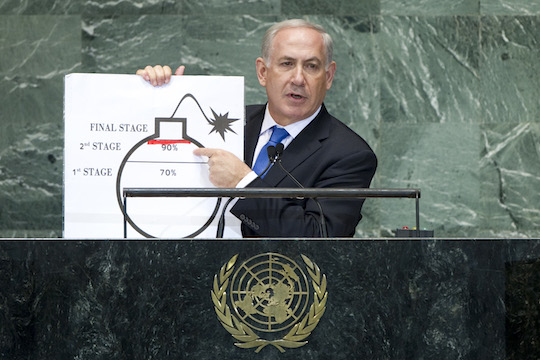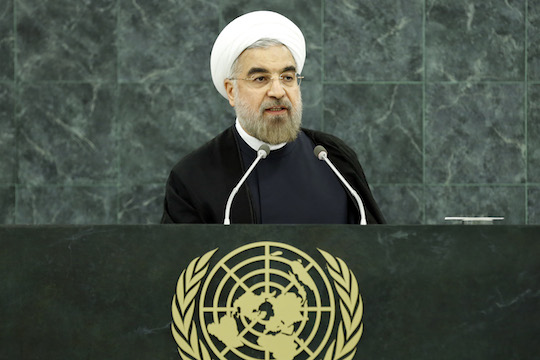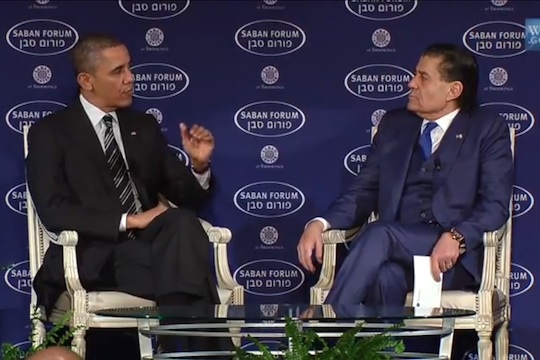President Obama’s exceptional appearance at the Saban Forum amounts to an authorized interpretation of the nuclear agreement with Iran. Israeli leaders should be paying attention to the points he made.
By Shemuel Meir
The nuclear agreement with Iran, known as the “Joint Plan of Action,” which was signed in Geneva on November 24 between Iran and the superpowers is a great American diplomatic achievement with positive implications for Israel’s security. The agreement limits Iran’s capability to enrich uranium and begins to “roll back” those elements of Iran’s nuclear program that possess dangerous military potential. This is an agreement that has moved Iran off the nuclear weapons path and imposed on it strict and intrusive supervision. But that’s not the picture that was presented to the Israeli public.
The Prime Minister’s Office (PMO) and the security establishment dictated the tone of the public discourse that followed. From the PMO’s overreaction (“a bad deal”) and the majority of editorial columns appearing in Israeli newspapers, it appeared that Iran would not even for a moment stop its race to a nuclear bomb, and that Israel has been abandoned. All the spins and the incorrect interpretations have obscured the facts of what really happened in Geneva. The Israeli discourse has seen an overwhelming use of metaphors – “Munich 1938” “existential threat”, “the centrifuges keep spinning,” “it is all tactics and Iran is dragging its feet” – rather than facts and the media has taken to using headlines from the field of nuclear strategy and technology unaccompanied by accurate explanations or contexts.

But before delving into the text of the deal, it is worth noting that the agreement became possible when a robust common basis was created between the U.S. and Iran (apparently via a secret channel that ran parallel to the talks with the superpowers). On the one hand, Iran was fully aware that the existence of a civilian nuclear program is dependent on strict adherence to the Nuclear Non-Proliferation Treaty (NPT). Meanwhile, the U.S. returned to its original interpretation of the NPT which led to it signing the treaty in 1968. According to the original interpretation, the enrichment of uranium for civil purposes under IAEA monitoring is not a violation of the treaty. The result was the Geneva Agreement, which showed just how small the chance is that Iran will withdraw from the NPT and take the military nuclear path.
The central point of the agreement is the following: Iran declares and undertakes, for the first time in a document signed with the U.S., that it “reaffirms that under no circumstances will Iran even seek or develop any nuclear weapons.” This constitutes a reaffirmation of Iran’s obligations under the NPT (to which it has been a signatory since the first day of the treaty’s existence) not to develop nuclear weapons, and is complimentary to the “declaratory policy” expressed in President Rouhani’s UN speech in September, that there is no place for nuclear weapons in Iran’s nuclear doctrine.

In return, Iran will be permitted to enrich uranium at a low level for civilian purposes (up to 5 percent, which is the level necessary to enriching uranium for electricity reactors) under tight IAEA safeguards (more on this below). The final agreement will include “a mutually defined enrichment program with practical limits and transparency measures to ensure the peaceful nature of the program.”
In this context, there is no basis for the Israeli PMO’s claim that permitting low-level uranium enrichment is a violation of international agreements and Security Council resolutions. Safeguarded low-level uranium enrichment will not enable Iran to stockpile fissile material for a bomb (93 percent uranium enrichment). Low-level enrichment is not a violation of Article 2 of the NPT, which forbids development and purchase of nuclear weapons. After Iran abides by all the agreement’s obligations, it will not be different from other countries such as Argentina, Brazil, Japan and Germany, all of which enrich uranium at a low level under IAEA supervision; no one claims these states are nuclear weapons countries or “threshold states.”
![U.S. Secretary of State John Kerry and his fellow P5+1 foreign ministers, as well as Iranian Foreign Minister Javad Zarif, center, listen as European Union High Representative Catherine Ashton speaks at United Nations Headquarters in Geneva, Switzerland, after the group concluded negotiations about Iran’s nuclear capabilities on November 24, 2013. [State Dept.] An important year for Iran nuclear talks: What Israel got wrong](https://static.972mag.com/dev/uploads/2013/12/genevaagreement.jpg)
Regarding the main centrifuge site in Natanz (where uranium enrichments is up to 3.5 percent), it was agreed that at this stage Iran will be permitted to operate only half of the centrifuges at the site – (8,700 out of 18,000) and that there would be no deviation from the stock of uranium as it stands to date, i.e. 7,150 kilograms. From the paragraph in the agreement that speaks of “practical limits” regarding uranium enrichment in a future permanent agreement, we can conclude that the number of centrifuges will be decreased. The important point regarding Natanz – the 1,000 “second generation” fast centrifuges will not be connected and will not operate. These advanced fast centrifuges were a crucial element in the scenarios of “a quick breakout capability in 6 weeks” developed by think tanks and the Prime Minister’s Office.

Regarding the “alternative route” to a bomb via plutonium. The “total freeze” and strict technical limitations imposed by the agreement on the heavy water reactor in Arak (whose construction has already been going on for 10 years and no end in sight) closes the door on the prime suspect regarding the development of a plutonium bomb – via the facility for reprocessing plutonium – using the used fuel rods from the Arak reactor. Iran has in the past notified the IAEA that it has no intention of building a facility to separate plutonium – and now in the Geneva Agreement is has committed to this obligation. Putting the Arak reaction under IAEA safeguards, the prohibition on building a plutonium reprocessing facility and the robust technical limitations in this agreement (not to operate of the Arak reactor, not to introduce heavy water, not to produce nuclear fuel, not to carry out nuclear fuel experiments) suggests that in the end there will be no heavy water reactor in Arak. This is possible signal of its transformation to light water reactor that would not constitute a threat (light water reactors were offered to “lawless” North Korea if it would withdraw from the military nuclear route).
Obama offers an official interpretation of Geneva
The Geneva Agreement is at first glance a six-month agreement with a renewal option. But from the text – and the emphasis on the central elements of the permanent agreement – we can conclude that it provides the scaffolding for the final agreement. In the end, Iran will have a modest and limited program of low level uranium enrichment for civil purposes and under a tight inspection system. This was the main motive of President Obama’s presentation at the Saban Forum when he detailed the end-state outline.

President Obama’s exceptional appearance at the Saban Forum amounts to an authorized interpretation of the nuclear agreement with Iran. It is therefore worth paying attention to the central points that he made. The first was intended to refute a claim that is widespread in Israel and used freely by many as if it is taken for granted. In his detailed answer to a question from General Amos Yadlin, President Obama effectively clarified that Iran is not a “nuclear threshold state” and that the US will not allow it to reach that stage.
The “threshold state” concept was originally intended to characterize the few states that had not joined the NPT and were suspected of developing nuclear weapons – India, Pakistan, Israel, South Africa, Argentina and Brazil. The three latter have “returned to the fold,” by abandoning the “threshold” in the 90s and rolling back the nuclear plans of which they were suspected, when they became members of the NPT as non-nuclear-weapons states. India and Pakistan abandoned the “threshold” in the opposite direction and carried out nuclear explosions. Israel has remained the only member of the nuclear ambiguity club.
In his answer to General Yadlin, President Obama explained that theoretically, Iran could have “the breakout capability.” But in practical terms, the strict limitations on its low-level enrichment program and the intrusive IAEA monitoring provide a good guarantee that Iran would not have a “breakout capability.” According to the agreement, Iran will be placed under a “unique and unprecedented” verification and monitoring mechanism. Already in the first stage, IAEA monitors will be given access on a daily basis to the centrifuge sites, to the facilities for the production and storage of centrifuges (that until today were “off limits” to the IAEA). In this way, Iran undertakes already in the first stage some elements of the “Additional Protocol” (based on the lessons learned from Saddam Hussein’s clandestine program) which permits intrusive snap inspections at short notice, including at undeclared suspected sites which will prevent the possibility of secret stockpiling of fissile material for a bomb going unperceived by the inspectors. This will prevent the possibility of a clandestine route to nuclear weapons.
It is worth remembering that to date, Iran is the most monitored country in the world – inspectors are permanently and continually in place in Iran, video cameras broadcast directly to the IAEA headquarters in Vienna. The US intelligence effort through satellites recall operations over Soviet territory during the Cold War. The satellite coverage is more than photography and includes the collection and interpretation of activities on the basis of samples of material released into the atmosphere. In addition, there is the NSA tracking of signals. In the nuclear context, tight monitoring is the best confidence-building measure.
The second point explicitly emphasized by President Obama in his speech at the Saban Forum was that the North Korean model was not applicable to Iran and that there is no room for comparison between the two cases. President Obama emphasized the fact (based on intelligence material) that when the U.S. entered into negotiations with North Korea – the latter already had fissile material for nuclear weapons. North Korea had never been a full member of the NPT. It entered the treaty in an irregular and late manner, withdrew in 2003 and carried out its first nuclear explosion in 2006. The huge difference between Iran and North Korea can be found on the declarative level: North Korea according to its constitution is “a state armed with nuclear weapons” while Iran is an NPT country which, in the Geneva Agreement, has reaffirmed that it will not develop nuclear weapons. President Obama thus put an end to the North Korea spin.
At Saban Forum, President Obama tried to signal (with admirable tact) to Israeli leaders that the prevalent concept according to which “there is nothing new in Iran” should be reexamined. That the importance of the political change in Iran should not be underestimated. President Rouhani’s sweeping electoral victory reflects a change of direction in Iran. An understanding of the global reality of the NPT regime (no to nuclear weapons, yes to civil nuclear programs) and the reality of the new Iran – these explain what happened in Geneva. The explanation is not to be found in an imagined US. naiveté. President Shimon Peres, who recently said in public that Iran is not an enemy state, seems to share President Obama’s assessment.
Shemuel Meir is a former IDF analyst in the Strategic Planning Department and associate researcher at the Jaffee Center for Strategic Studies at Tel Aviv University. Today he is an independent researcher on strategic issues and owner of the Strategic Discourse blog which appears in Haaretz.
